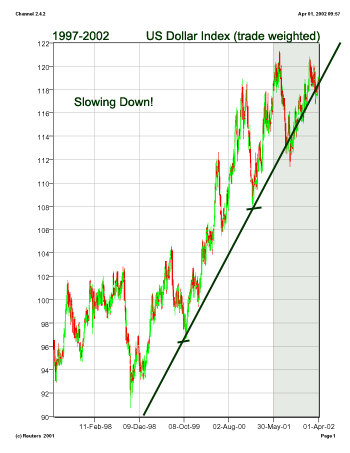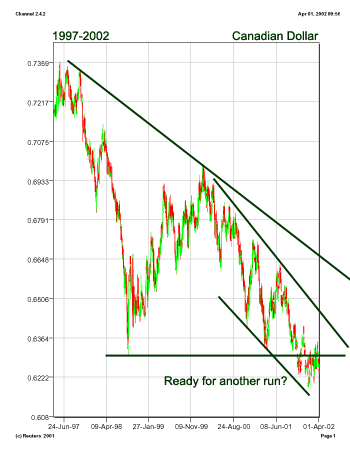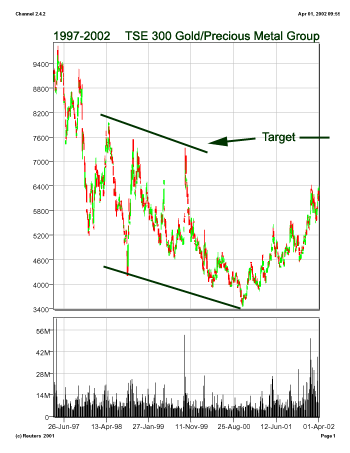01 April 2002
Printer Friendly Version
Mr. Greenspan, would
you please do something about this (see chart) before it gets outta' hand?
Greenspan says, "What would you suggest son?"
?: Well the boys down here in the bond pits are concerned about your leadership again. They're not sure whether you're a stock or bond bull. You've got them all spooked with talk about inventory drawdowns and a recovery in production rates. The thinking is getting around that maybe you've become a stock bull after all.
Greenspan: "You don't say. Well, we don't target asset prices at the Fed. We target interest rates. But you're right, it's tough to justify a low Fed Funds rate if long term bond yields won't stay down. The administration can't seem to get its act together on the budget, and now, it's starting a trade war. They're stirring up trouble in the dollar. How can we keep interest rates low like this? Clinton understood."
?: C'mon now Alan, don't put this one on the President, you know you've been blowing smoke up everybody's bums about the economy all along. How did you think that would affect yields? All you've done is displaced inflation expectations with high investment expectations.
Greenspan: "We did no such thing. I'll explain it to you over lunch. Don't let the door smack you in the behind on the way out."
I'm only guessing that's how a conversation between Mr. Greenspan and the head of an investment bank making a market for Treasury securities might sound, early this week. Then again, that conversation may have already occurred. The timing is about right for the Fed to get bearish on stocks, or to deflate investment expectations if you will.
With confidence on the rise, commodity prices bubbling, real estate prices exploding, hedge books bleeding, government outlays expanding, and trade policy limping there is only one way to keep interest rates and yields low. Hammer the stock market.
What about the dollar though? Won't a collapse in the US dollar give rise to inflation expectations in the US economy? Perhaps not if reeling stock prices introduced a good old fashioned Keynesian demand shock to the financial system.
But then, what about gold? If this so-called demand shock reverberates through foreign economies, and the dollar rises at their expense what will foreign gold producers (with hedge books hedged for a falling US dollar) do? So much for the strong dollar.
So now, the dollar can neither rise nor fall. If it rises, Australian and South African hedge books are up for sale. If it falls, investment demand for gold can be found emanating from the US. So it's time for policymakers to hone in on specific currency relationships.
Supporting the yen now, for instance, is a terrific way to cool off the new class of gold bull arising out of Japan's decay. Supporting the Australian dollar and South African Rand is an effective way to raise the break even value of hedge books in the region, and it keeps the pressure off those producers faced with the dilemma of liquidating their hedges into a rising gold market.
If gold prices are indeed a target of US economic policy (auxiliary or direct) then policymakers will be faced with the task of maintaining confidence in the dollar generally, with the aim of restricting growth in the investment demand for gold, overall, but also by adjusting specific exchange rate relationships in order to target potential hot spots for this kind of demand.
At the moment, these hot spots are Japan, Australia, South Africa, and other parts of Southeast Asia. Currencies here have been the weakest, and hedging activity has as a result been the strongest, in the past, at least among those regions where the gold industry exists. Further weakness in these currencies, however, means that local gold prices are that much stronger, which has become detrimental to the foreign producer's ability in maintaining its currency and gold hedges.
This presents a big problem for dollar
bulls because the thrust of their strength over the past year or so has
been from a fall in the Japanese Yen and South African Rand, by 10% and
60% against the dollar respectively.
The European currencies are gaining some strength now, but the affect that a strong Euro may have on gold might be offset by a pick up in investment demand for gold bullion in the US. The question dollar bulls must ask now is whether a falling dollar will spur growth in this demand beyond that which it dissuades off shore.
It shouldn't matter, because a falling US dollar should also persuade production cut backs off shore.
The US dollar has been in a 6-year bull market, but had lost its broad momentum by 2001, and consequently under performed the gold price for the first time in that six-year stretch.
Now, several factors threaten to undermine its performance relative to other fiat currencies:
- A Trade war
- A Sticky Current Account Deficit
- Bearish interest rate differentials between US and other nations
- Bearish inflation rates (which are higher in US than any of the G7)
- Budget decay
- Peaking consumption trends in the US, and
- a Potentially falling investment premium on dollar assets
Haruko Fukuda, the World Gold Council's CEO, is reportedly confident that the eleven Euro area central bankers will renew the Washington Agreement in 2004, perhaps for ever, she said. But then, it could be that fresh strength in the European currencies will dissuade such speculation.
Judge Lindsay ruled against Reg Howe, in the case of Howe versus the BIS (Bank for International Settlements). Disappointing, but not too surprising in light of recent events and government machinations.
The Judge said that Reg had no standing and that Greenspan and O'Neill were above the law (had sovereign immunity) anyway. The only comment we'll make is that this case no longer represents an axe of uncertainty overhanging the gold market. It is out of the way, and thanks to Reg and GATA, the whole world is beginning to know the truth anyway.
One thing is for sure, the whole world is beginning to notice the relative strength of the gold market. Gold equities were reported to be the 2nd best performing stock sector in the first quarter, 2002:
- HUI (Amex Gold Bugs index) = +57%
- XAU = +32%
- SP 500 Gold index = +28%
- TSE Gold and Precious Metal group = +26%
The best performing S&P500 sector was the Semiconductor Equipment index, which was up 30%. In third place were the S&P 500 Diversified Metals and Mines.
But broad stock market victory in the first quarter of 2002 goes to gold shares in the first quarter. That's after a robust 2001 where the S&P gold index was up 12%, and the TSE precious metals index was up 16%. Forget about the great fourth quarter GDP news. That's looking in the rearview mirror. This sector is telling us something else about the economy, entirely.
At any rate, note how the US gold indexes
overtook the Canadian gold shares in the most recent quarter. The main
explanation lies in the relationship between the US and Canadian dollar.
In 2001, the C$ fell by 7 percent against the USD. So far in 2002, the
CAD is down against the greenback by only a fraction of a percentage point,
but that is due to recent weakness. As of the high point in March, the
C$ was up against the USD, by a little more than 1%.
The Canadian dollar is one currency that puzzles us, but perhaps that's because we live in Canada. Having said that, and although we've got our share of gold hedgers, it is possible for the Canadian dollar to become the sacrificial lamb for dollar policy, with regards to managing the gold price (or demand) at any rate.
In allowing the US dollar to fall against specific foreign currencies in order to manage the global investment demand for gold US policymakers cannot let the US dollar slide precipitously. A declining CAD may be the least of all the evils in the context of what currency collapse will pose the least threat to gold prices.
Moreover, a falling CAD may be able to help contain some (USD) inflationary pressures boiling to the surface in other commodity markets, and it can thereby help contain the temporary upside momentum in the Japanese Yen, and Australian dollar. Or maybe that's how it is perceived.
On the contrary, however, if this turns out to be true we're looking for the Canadian unhedged gold producers to light up the sky in 2002 alongside, and maybe in front of, their American counterparts.
In a February daily commentary (Prisoner's Dilemma Resolved) we suggested to our readers that gold stocks were about to embark on a primary trend reversal, which meant certain target ranges for the major gold bourses in North America. Here they are:
Primary Trend Reversal Points
- 80 on the SGOLD
- 93 on the XAU
- 100 on AMEX HUI
- 7500 on the TSE Gold index (25%)
 The
AMEX gold bugs index has made it, and is just about in a genuine primary
bull market. The S&P gold index is about half of the way, and the others
are just under half way there.
The
AMEX gold bugs index has made it, and is just about in a genuine primary
bull market. The S&P gold index is about half of the way, and the others
are just under half way there.
At the moment, our hypothetical portfolio is weighted 25% in bullion and nearly the same amount is allocated to gold equities since October 2001. Should our targets be achieved, we may or may not lighten the load on the equity front. But until that time, our investor is definitely going to let it ride.
We think the US dollar has had its best days. And they weren't in 2001.